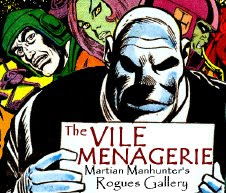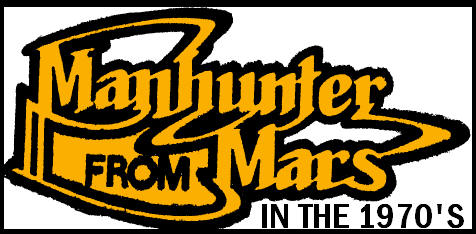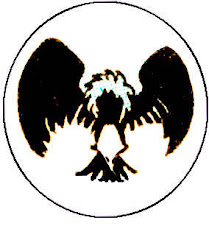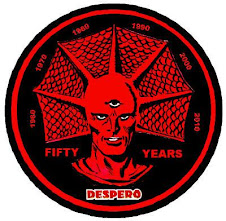...time and again. Yes folks, I'm feeling ranty tonight.
The Manhunter from Mars debuted in 1955, at a time when Batman comics were not doing spectacular business. I don't know if J'onn J'onzz helped, but you have to figure appearing in 101 consecutive issues at a time when sci-fi was big, it couldn't have hurt. Over the course of those eight years, the Manhunter from Mars strip outlasted every other feature in the book but Batman's, and Detective Comics editor Jack Schiff once said, "We used to get a lot of mail on that." Sales dropped by about 65,000 copies per issue between 1961 and 1962, with both Schiff and John Jones shuffled off to another book to make way for incoming editor Julie Schwartz, artist Carmine Infantino, and feature The Elongated Man. By 1965, sales were up about 40,000 copies, and at the height of TV Batmania rose another 120,000.
The Manhunter from Mars strip moved to House of Mystery, which saw circulation rise over 20,000 copies. Shedding 13,000 readers the following year, it was joined by the cover featured Dial "H" for Hero strip, and the title dropped another 25,000 units. A change in format to an all horror anthology saw the book rise substantially, peaking at a gain of 30,000 copies to an average of 187,408 in 1971. In his time as lead feature, J'onn J'onzz appeared on only nine of thirteen covers, while Dial "H" for Hero was on each of the eighteen covers in which it crowded in as co-feature over the book's decline.
Given that the Martian Manhunter had no apparent sales impact on Justice League of America, prompting his departure from that book, it's safe to say the Martian Manhunter wasn't all that popular, and Robby Reed even less so. He surely had some fans, whose letter writing helped the Alien Atlas make guest appearances throughout the 1970s and early '80s, and almost landed him another regular gig before the DC Implosion. Still, his importance was fairly negligible.
The Martian Manhunter returned to the Justice League in the mid '80s, which prompted Kenner to produce an action figure for The Super Powers Collection. I don't have sales numbers, but my anecdotal experience was that the toy warmed pegs alongside Dr. Fate and Plastic Man until they were finally blown out through bargain bins. Justice League of America wasn't selling especially well either, so once again, J'onn J'onzz's worth to the company at the time was questionable. For instance, Alan Moore and Dave Gibbons were going to do a Martian Manhunter mini-series before Watchmen, until DC decided not to bother.
In 1987, a relaunched Justice League revolutionized the industry and became a top-selling comic. Tie-in ongoing series for Mister Miracle, Blue Beetle, and Booster Gold each failed within two years, and Dr. Fate did a little better than three. I only have Capitol City Distribution numbers, which had Beetle selling 11,900 on its final issue, Gold 15,000, and Fate in the high teens during the same decade. Captain Atom, which ran five years, was posting similar numbers. Capitol City was selling better than twice as many copies of any given Justice League book, but DC couldn't seem to capitalize on that success with any spin-offs until they added a second team book, Justice League Europe.
The Martian Manhunter was one of the most visible members of the Justice League during its flush years, but rather than take a chance on another series, DC gave him four issues of a direct market only mini-series that cost more than twice that of a standard comic. It also featured horrendous, broadly panned art by Mark Badger, and an obtuse story by Justice League co-writer J.M. DeMatteis. Its first issue sold 28,800 copies through Capitol City, and its last 17,200. There were no follow-up attempts until four years later, during which time an unrelated series titled Manhunter written by John Ostrander ran for two years with average Capitol sales between the low teens and high single thousands.
In 1992, the Martian Manhunter disappeared from mainstream comics, just as he was voted in a poll taken by DC Comics of the attendees of various conventions the second most deserving character of a solo mini-series, after Death. The mini-series he received was a noir thriller set in the late 1950s with retro art by Eduardo Barreto, mostly featuring a plainclothes John Jones. It was a challenging story available in the direct market only in a prestige format costing five times that of a normal comic for only twice the story pages. Each of the three issues had virtually identical covers except for the background color. The mini-series sold about half as many copies as contemporaneous Justice League titles in the direct market. Two years later, an unrelated ongoing series titled Manhunter ran for a year with dismal sales.
In 1993, the Martian Manhunter and his sidekick Gypsy were the constants in a new book called Justice League Task Force, which featured additional members who were altered from story arc to arc, each by different writers. I'm sure the all New Blood and all C-list girl squads (plus Wonder Woman) sold gangbusters. After a year, the format changed to a static team that added Triumph, the Ray, and Despero to the line-up. It was selling about three quarters as well as the main J.L.A. title, which starred Wonder Woman, Hawkman, and the Flash. Sales were comparable to Extreme Justice, starring Captain Atom, Blue Beetle and Booster Gold. The only attempt to exploit the Martian Manhunter was a one shot special seemingly cobbled together from leftover material after Justice League Quarterly was cancelled. Actual unit sales aren't readily unavailable, but a good guesstimate would be about 17,800 (based on the 73,704 copies of Batman #536 sold four months later, with the special having sold 24.20% as well as Batman #532. However, #532 had a glow-in-the-dark cover, so the special's numbers might have been closer to 20K. Also, the special cost twice as much as a standard comic, ranking #56 for the publisher that month.)
In 1997, JLA #1 sold 104,486 copies through Diamond Comic Distributors. In October 1998, #23 sold 95,255. The parallel issues of Superman sold 64,361 and 49,374. Batman: 67,777 & 45,603. Wonder Woman: 42,361 & 33,460. The Flash: 47,586 & 40,906. Green Lantern:51,558 & 58,782. Aquaman: 33,929 & 25,004. In October of '98, the first ever Martian Manhunter ongoing series debuted with a #0 issue selling 43,272. Here are the comparative sales of these books a year later in November, 1999:
JLA #35: 83,388
Green Lantern #106: 58,782
Batman #571: 51,717
Superman #150: 40,458
Flash #154: 39,444
Wonder Woman #150: 27,084
Martian Manhunter #12: 26,303
Aquaman #61: 22,403
The Martian Manhunter creative team of John Ostrander and Tom Mandrake had previously worked on The Spectre, which sold 20,726 copies the month JLA #1 went on sale, and 19,660 copies of their title's last issue in February of 1998. That was about par for the final years of the book. On the strength of the character, a #0 issue, and ties to JLA, Martian Manhunter outperformed against three other titles starring JLA members, and better than doubled The Spectre's sales. By #16, Martian Manhunter was selling in the same range as The Spectre had been doing. By the final issues, it continued The Spectre's trajectory into the mid-teens in sales. So basically, The Spectre's creative team were doing The Spectre's numbers, and this was after Ostrander had already written the previously mentioned Manhunter series of the '80s. A few years later, Ostrander shifted most of his work to Dark Horse, where he's been ever since.
In August of 2004, yet another unrelated Manhunter series debuted with sales of 25,517, less than all but one issue of the first year of Martian Manhunter. The publisher "believed" in the character, so they cancelled and revived the book twice before ending it for good at #38. At the same time, the Martian Manhunter was appearing on the popular Cartoon Network show Justice League.
In August of 2006, five years after the Martian Manhunter ongoing series' cancellation, an eight issue mini-series debuted to the tune of 41,263. That same month, issue #25 of the other Manhunter series sold 15,175 copies. The new Martian Manhunter creative team of A.J. Lieberman and Al Barrionuevo had seen Batman: Gotham Knights cancelled by selling less than half as many copies as Batman, with their final issue moving 29,689 units. The final issue of Martian Manhunter sold 22,185 units, and had competed the entire time with Manhunter, the same month selling 17,234 copies. The Martian Manhunter mini-series seemed like a sort of last chance for Lieberman and Barrionuevo. I don't believe the writer has written any other comics since then, and until Stormwatch #2, the artist had only worked on one mini-series and a few guest jobs over the course of 4 1/2 years. For comparison, DC cancelled several Aquaman and Hawkman series for the "stink" to come off them, then returned with popular creators on new books. J'Onn waited five years to get creators with a fresh stink of cancellation on themselves, and they proceeded to redesign the character to look like a vegetable and tell a story that made no sense in narrow little panels. Fans hated and/or ignored it.
In 2008, Final Crisis: Requiem, a tribute to the Martian Manhunter following his death in an event series, sold 74,310 copies. The Martian Manhunter remained dead for less than two years before being revived in Blackest Night and co-starring in the maxi-series Brightest Day, each serving as bestselling DC titles in their respective years. Brightest Day had numerous spin-offs.
Aquaman: Titular star of 5 ongoing series, 3 mini-series, and numerous specials since 1955, featuring legendary creators like Jim Aparo, Dick Giordano, Nick Cardy, Romana Fradon, Peter David, Keith Giffen, Curt Swan, and now Geoff Johns and Ivan Reis.
Firestorm: Titular star of 4 ongoing series, whose 100 issue title ended under the creative team of John Ostrander and Tom Mandrake. A second series ran less than three years under relative unknowns. The third series offers stars Ethan Van Sciver and Gail Simone.
The Hawk & the Dove: Titular star of 3 ongoing series, none of which have lasted three years, as well as two mini-series. Superstar Rob Liefeld has worked on two series, while Steve Ditko and Gil Kane carried the original.
Hawkman: Star of 6 ongoing series, 2 mini-series, and numerous specials. Creators have included Gardner Fox, Joe Kubert, Murphy Anderson, Alfredo Alcala, Tim Truman, James Robinson, Geoff Johns, Rags Morales, Howard Chaykin, and Walt Simonson.
Deadman: Titular star of 4 mini-series and numerous anthology books by the likes of Arnold Drake, Neal Adams, Jose Luis Garcia-Lopez, Doug Moench, and Kelly Jones.
Martian Manhunter: Titular star of an ongoing series, a special, and 3 mini-series, none of which have ever featured A-list talent, and the primary creators having been involved in the cancellation of at least two series involving other Brightest Day spin-offs. Despite a veritable who-who of creative unknowns, the Martian Manhunter remains one of DC's most popular and visible characters. Instead of receiving any kind of support within the company, he is constantly thrown under the bus, usually competing with at least one other character using the Manhunter name who gets their own ongoing series despite every single one of them failing miserably and being swept aside. Paul Kirk was in a handful of issues of Detective Comics. Mark Shaw, Chase Lawler, Paul DeKirk and Kate Spencer have had negligible existences and no cultural impact whatsoever, but were deemed more important than J'Onn J'Onzz upon their launches. Green Lantern debuted a corp of robotic Manhunter villains decades after the creation of the Martian Manhunter, which have had extend periods as moribund properties, and DC still refuses to retire or rename them. For H'ronmeer's sake, the Justice League cartoon decided that since they used the Manhunter Corps in an early two-part episode, they would refer to the Martian Manhunter simply as J'Onn J'Onzz for four seasons and every related direct-to-DVD movie to date!
The Martian Manhunter did not get a big shiny bestselling New 52 #1 in September. He'll be lucky if he gets a mediocre later DCnÜ #1 in 2012. Since he's never had a big name creative team in his entire existence, don't expect one now. While the Manhunter from Mars may not have been any great shakes from 1955-1985, the quarter century since has made him a highly visible super-hero inside and outside comics that consistently performs well in popular character polls, including one at CBR this year that ranked him directly behind the renewed Aquaman (after beating him previously.) This popularity is in spite of DC Comics, who consistently cut the character off at the knees, systemically ignore thirty years of his history, leave him off their flagship team, never offer him a ginchy "enhanced" cover, sabotage him with conflicting Manhunter series, offer him mini-series "scraps" as an afterthought, handicap him with expensive formats, and offer him only discount talent. Look at the numbers above, and tell me the Sleuth from Outer Space hasn't performed admirably in the face of overwhelming adversity. Tell me he hasn't been biased against while lesser lights have seen multiple series greenlit despite repeated crushing failures. You tell me that, and then you might as well light a match, because I know where you're coming from and the stink you're emitting.
Subscribe to:
Post Comments (Atom)





























11 comments:
I love the passion and agree with the sentiment here.
The biggest thing for me is that all these prior stabs at Martian Manhunter books just haven't had a strong enough creative team to make me say it is a 'must book'. I think a J'onn book written and drawn by the right people could be a great.
Even Stormwatch is a tough sell for me. Because I don't want to read about J'onn and Wildstorm characters.
I do want to read about J'Onn and Wildstorm characters, but not as the sole outlet for Martian Manhunter stories, and not necessarily these Wildstorm characters. They've introduced three entirely new characters, are introducing five others to DC readers, and two of them are highly derivative of Superman and Batman. A nine member team is too big, and too much focus has been given to the least interesting characters.
I'm pretty sure you could write the same post for Supergirl. I'd read and bless it. :)
The tone of this perfectly fits my mood today; everything sucks, and it's all so unfair.
I feel like the appeal of the character is largely in the outsider aspect (cerebral/sensitive/alien/loner) and the kitsch factor (50's/sci-fi/noir/barbarian/spy). I get the sense that the powers that be never quite "get" the appeal, and so they never put the right pieces in place.
Oh well... Stab.
I always have hope that someday they will actually have an on going with Jonn but I won't hold my breath for it.
I hope that J'Onn will get the respect that he deserves, and get some good creative talent working on him. My hope is that the ranks of Stormwatch will get thinned out and we will see more on the individual characters. (How about a story of how J'Onn joined Stormwatch in the 1950s and worked with Jenny Sparks in saving the Earth from a few invasions.)
J'Onn has a wonderful back story, and maybe a good writer can reconcile different versions of it into a more coherent whole. I think that J'Onn has shown that a character can overcome great adversity and persevere -- both in the comics and in the run of his comics.
I would love it if Paul Cornell or whoever works on J'Onn could come here for some ideas or at least learn about the character's background. That may be asking for a winning lottery ticket, though.
Frank, I think this is the post I've been waiting for for my entire I-HoD reading career. You've made an excellent case that there is obviously something drawing fans to the Martian Manhunter regardless of who the creative team is or isn't.
I suppose that's both hopeful and sad at the same time: I don't think DC is going to do him justice in the near future, but at the same time, his fans will stick with him.
Obviously we all see something in J'onn J'onzz. I can't fathom why DC doesn't "get" it, especially when there are actually sales numbers to show there's a market for him. It's just so infuriating. I'm still smarting from J'onn being left off of JLA. To me, it's a symbolic act saying DC doesn't take him seriously. I had such high hopes after he was resurrected in Brightest Day.
"J'Onn has a wonderful back story, and maybe a good writer can reconcile different versions of it into a more coherent whole."
Will, I have a follow-up post in mind to cover that, but you're right, a lack of historical perspective has seemed to limit creativity by simply repeating the same types of Post-Crisis stories.
"Frank, I think this is the post I've been waiting for for my entire I-HoD reading career."
Jeez Liss, I wish I'd done it better then.
"You've made an excellent case that there is obviously something drawing fans to the Martian Manhunter regardless of who the creative team is or isn't"
Why thank you. What seems to happen is that J'Onn opens well, but ends up selling the same as his creators would on any other book. Don't get A.J. Lieberman if you want Geoff Johns numbers, or hell even Ostrander ones. Can't make pâté out of dog food. It does seem like they resurrected J'Onn just in time to neglect him again.
Edited into the post:
"The only attempt to exploit the Martian Manhunter was a one shot special seemingly cobbled together from leftover material after Justice League Quarterly was cancelled. Actual unit sales aren't readily unavailable, but a good guesstimate would be about 17,800 (based on the 73,704 copies of Batman #536 sold four months later, with the special having sold 24.20% as well as Batman #532. However, #532 had a glow-in-the-dark cover, so the special's numbers might have been closer to 20K. Also, the special cost twice as much as a standard comic, ranking #56 for the publisher that month.)"
Well here's something you could do: not invest yourself personally in what happens to comic books starring a fictional character. If you tried that method, you might notice that Andreyko's Manhunter book was pretty much a modern comics masterpiece.
Characters don't matter, unless they're Batman, Superman, Nightwing, Robin, Flash, Green Lantern, Wonder Woman, Captain America, the X-Men, Wolverine, or Spider-Man. If it isn't one of those names, then what matters is creative talent.
Anonymous, that's a pretty shabby argument. If a reader doesn't personally invest in their characters, what good is a writer's work? I don't expect you'd have such a snotty response if you yourself weren't personally invested in the Kate Spencer Manhunter, so it's not a little hypocritical, either. I tried that Manhunter for about six issues, and didn't care for it. It reminded me of Alias in the soap opera cliffhangers, so that I never felt like any issue ended, just rolled into the next. Regardless of my personal preferences though, would the book have been any less accomplished had it been named Nemesis or Stalker or some other moribund DC trademark? I think you missed the point, that DC undercuts the potential of the Martian Manhunter brand by constantly introducing other competing Manhunters. I agree that talent matters, which is why it frustrates me that DC doesn't give the Martian Manhunter any that could help build the character as a marketable property, given that his visibility and popularity have grown steadily for decades.
Frank, I did link to your post over at Comic Book Resources -- http://forums.comicbookresources.com/showthread.php?t=390458&page=5 . Maybe we can get a few people over here.
I think that readers identify with characters in any form of fiction, and a well written protagonist can draw readers into a story. I think that J'Onn deserves better than he has seen -- let's face it, he has dealt with tragedies that would break many others and still chooses to have faith in humanity's promise. In some respects, J'Onn's faith in humanity may be needed more than ever in the DCnU. (It does help that J'Onn can take a very long term view.)
Thanks for the bump, Will! Threw on an extra hundred or so page views from our average the past couple of days.
Post a Comment